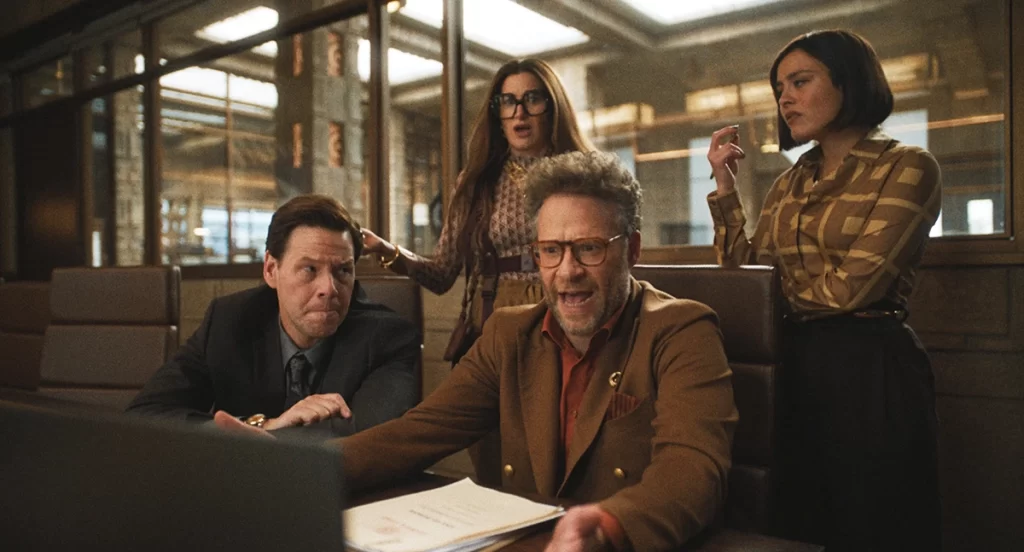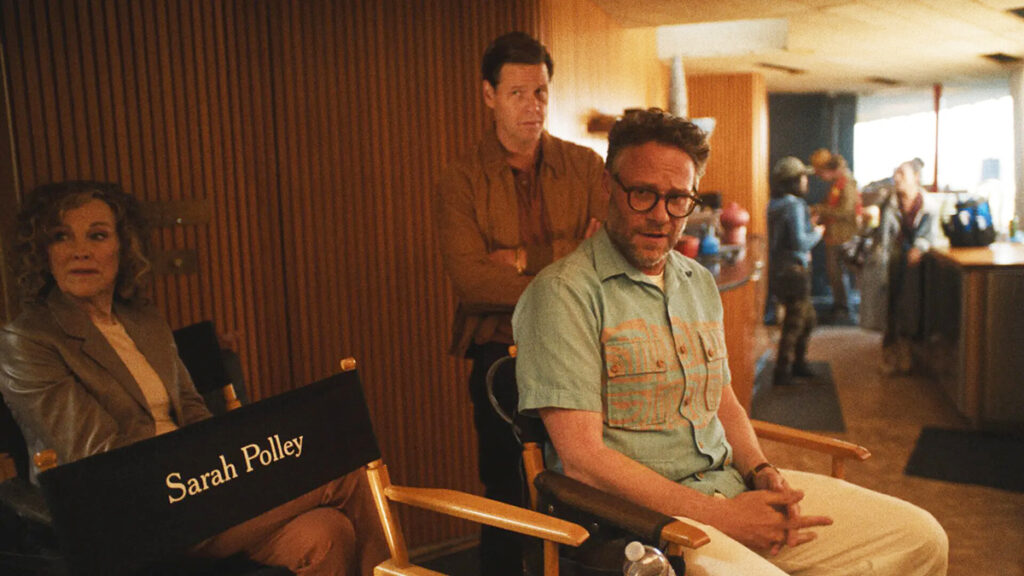In a world where reality itself seems more and more changeable, where boundaries between art business blur into an undiscriminating mist, a new show bursts out from the artistic whirlwind of Hollywood to reflect its own surreal, electrifying, frequently aching mirror. Seth Rogen’s ambitious foray into the behind-the-scenes operations of a classic movie studio, “The Studio,” is more than just a TV show. This philosophical treatise, disguised as a satiric, is a profound, hilarious, meticulously crafted treatise on the human condition. The quest for the intangible magic of art in a world obsessed with quantifiable success is a bold question to pose.
“The Studio” is nothing short of a masterclass in storytelling, a rarity that effortlessly blends razor-sharp wit with an underlying current of poignant observation. Here, Rogen not only acts but also contributes to the creation of this world alongside Evan Goldberg, Peter Huyck, Alex Gregory, and Frida Perez. The series’ core is Matt Remick, a character Rogen plays. As the head of Continental Studios, Remick assumes a position that can be both devoted and uncomfortable. Rogen’s portrayal of lived-in sincerity and obvious passion for movies makes “The Studio” much more than just an industry satire. He faces the existential dread of maintaining a massive business in a sector that is becoming more and more dominated by algorithmic demands, franchise weariness, and the constant search for the next big, lucrative IP.
Smart Wiring and Clever Writing
The unflinching commitment to accurately nail each detail is what sets this show apart, derived from Rogen and Goldberg’s extensive experience within the Hollywood machine. Rogen’s tame frustration and the executives’ somber mood are the ingredients for the hilarious cringe-comedy in the ‘Kool-Aid Movie’ pitch, highlighted by long takes and sterile cinematography that underscores absurd corporate demands. The smart wiring of the show becomes evident in how it seamlessly interweaves genuine cinematic passion with the soul-crushing realities of corporate mandates. It’s a dance between the artistic ideal and the commercial imperative, often resulting in moments of exquisite cringe-comedy that leave you laughing with genuine discomfort.
Meanwhile, the writing in “The Studio” is nothing short of brilliant—fresh, creative, remarkably real. It doesn’t rely on cheap gags or fleeting internet trends. Instead, it banks on character-driven humor derived from deeply flawed, relatable individuals caught in an insane system. The dialogue is sharp, often on-the-nose in a ‘Curb Your Enthusiasm’-esque fashion, allowing characters to blurt out their unfiltered thoughts anxieties, leading to anticipated, often uproarious, confrontations.
This smart humor isn’t just for laughs; it’s also a crucial tool for exposing the underlying anxieties and absurdities of the industry. The narrative perspective is consistently fresh, moving beyond a simple “Hollywood is bad” trope to explore the genuine struggles of those who love cinema but are forced to navigate its increasingly treacherous landscape.
Unpacking “The Studio’s” Layers of Detail and Meaning

The abundance of hidden details encourages multiple viewings and rewards the attentive audience. The series features subtle references to classic films, industry anecdotes from real life, and clever use of Bldg 140 at Warner Bros. For movie fans, this is a truly valuable resource.
On the other hand, the main philosophical dilemma is fully encapsulated by the recurring metaphor of ‘painkillers vs. vitamins’, which perfectly conveys its need for, albeit unappealing, commodities or its value as a nourishing, enriching experience. The series also talks about films like “The Player,” which featured Griffin Mill as a character, and “Birdman,” which used its score as temporary music. The experience is enhanced for those in on the joke by a knowing wink that hints at composer Antonio Sanchez‘s eventual involvement.
As for the technical merits, it’s simply breathtaking. The cinematography, characterized by daringly long, uncut takes, is a feat of immersive storytelling. This deliberate choice, reminiscent of the “oner” from “Birdman” or “The Bear,” isn’t just a stylistic flourish; it perfectly mirrors the manic, panicked energy of the studio environment. There’s no respite, no break in the action, creating a constant state of unease genuine immersion into the chaos. The camera movements are fluid, purposeful, often ingeniously executed, pulling the viewer directly into the heart of the frantic decision-making interpersonal dynamics.
On the other hand, the editing, though seemingly absent in the long takes, is a masterclass in pre-planning choreography, ensuring that every element within the frame serves the narrative. As noted above, Antonio Sanchez serves as the musical heart of the show. His score isn’t solely supplemental. Through an artistic oscillation between chaotic chaos and poignant introspection, this live adaptation captures the essence of both the relentless pressures and the faint, flickering hopes.
Strategic Cameos and Assured Direction
The use of cameos in “The Studio” isn’t just for star power; it’s a strategic, often hilarious narrative device. A-list celebrities and industry figures play exaggerated, self-deprecating versions of themselves, adding layers of meta-commentary comedic brilliance. The infamous confrontation between Matt and Martin Scorsese, or the prickly exchange with Ron Howard, are prime examples of how these appearances serve to deepen the show’s satire of Hollywood egos artistic compromises. It’s a testament to Rogen’s standing in the industry that these luminaries are willing to lampoon themselves so effectively.
The direction exudes kinetic confidence, with both Rogen and Goldberg demonstrating a keen understanding of pacing and tone. Each episode sprints its way to the finish, never letting the intensity wane, while also allowing for moments of unexpected emotional depth. They guide a stellar ensemble cast with precision, drawing out nuanced performances that are both hysterically funny and genuinely empathetic.
Stellar Performances, Relatable Arcs

Through it all, Rogen’s performance as Matt Remick is perhaps the most complex and compelling of his career. He portrays the inner turmoil of a man who is fond of movies but always finds himself forced to sacrifice his artistic integrity for the good of the company. His awkwardness, frantic energy, and underlying vulnerability make him a truly engaging protagonist.
Catherine O’Hara, as Matt’s mentor Patty Leigh, brings her signature deadpan humor and sharp wit, providing a grounding force amidst the madness. Ike Barinholtz as Matt’s often-exasperated partner-in-crime and Kathryn Hahn as the fiercely pragmatic marketing powerhouse Maya round out a phenomenal core cast. The supporting actors, including a brilliant Bryan Cranston as the studio’s demanding CEO, are all perfectly cast, contributing to the show’s rich tapestry of characters.
“The Studio” is a masterclass in character archetypes and story arcs. Matt Remick embodies a form of the “Change Arc,” where his initial belief in a pure, uncompromised cinema is constantly challenged, forcing him to confront the “lie” of Hollywood’s unyielding artistic integrity. Yet, there’s also a touch of the “Flat Arc” in his unwavering love for movies, a truth he holds onto even as the world around him descends into chaos. The supporting characters, though sometimes archetypal (the cynical executive, the ambitious assistant), are given enough depth to feel that their individual struggles contribute to the broader narrative of an industry in flux.
Profound Philosophy and Underrated Genius
The message philosophy of “The Studio” is profoundly timely. It’s a meditation on the precarious balance between art and commerce, questioning whether true artistic vision can survive the onslaught of corporate demands and audience metrics. Indeed, the show touches upon the discourse surrounding passion and pragmatism, and the trade-offs we must make to pursue our passions. It subtly suggests that while the industry may be in a state of chaotic flux, the human desire for compelling stories, for art that speaks to the soul, remains indomitable.
Despite its critical acclaim and undeniable quality, “The Studio” remains somewhat underestimated. Perhaps its meta-narrative and industry-specific humor might deter some casual viewers. However, this is precisely why it’s a must-watch: it’s a show that trusts its audience to engage with its intelligence, to appreciate its intricate layers, to find the universal truths within its specific setting.
Subtle Threads You Might Have Missed

For audiences who might have missed the hidden details or deeper implications, consider the subtle shifts in Matt’s moral compass as he navigates each crisis. Notice the recurring visual motif of reflections of glass surfaces, symbolizing the transparent (or perhaps, often distorted) nature of Hollywood dealings. Pay attention to the fleeting lines of dialogue that hint at the characters’ personal sacrifices for their careers. See how the show uses physical comedy to punctuate moments of extreme tension, a classic theatrical technique in a modern context.
“The Studio” is a journey that unfolds, and it’s not just about laughing. It acknowledges the soul of cinema with respect, and discusses its mercenary tendencies with precision; along with a gentle, memorable narrative that examines the persistent and sometimes wildly optimistic pursuit of personal legends.
“The Studio” is available to stream exclusively on Apple TV+.


